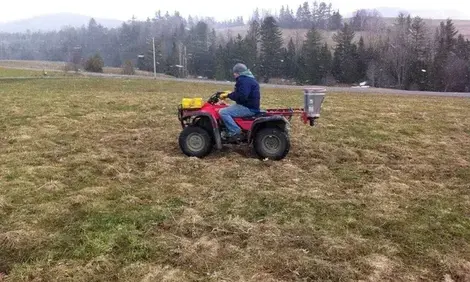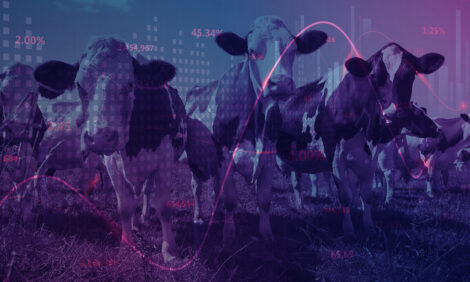



Weekly global protein digest: Texas and federal officials are ramping up screwworm monitoring efforts
Livestock analyst Jim Wyckoff reports on global protein newsWeekly USDA US beef, pork export sales
Beef: Net sales of 8,800 MT for 2025 were down 24 percent from the previous week and 28 percent from the prior 4-week average. Increases were primarily for Japan (2,500 MT, including decreases of 300 MT), Mexico (1,900 MT, including decreases of 100 MT), Hong Kong (1,400 MT), Canada (800 MT), and Taiwan (700 MT). Exports of 10,300 MT were down 27 percent from the previous week and 25 percent from the prior 4-week average. The destinations were primarily to South Korea (3,600 MT), Japan (3,100 MT), Taiwan (1,000 MT), Mexico (900 MT), and Canada (500 MT).
Pork: Net sales of 17,100 MT for 2025 were down 30 percent from the previous week and 48 percent from the prior 4-week average. Increases were primarily for Mexico (7,700 MT, including decreases of 1,000 MT), Japan (2,500 MT, including decreases of 300 MT), Colombia (1,500 MT), Canada (1,100 MT, including decreases of 200 MT), and China (1,000 MT, including decreases of 100 MT). Exports of 26,500 MT were down 12 percent from the previous week and 19 percent from the prior 4-week average. The destinations were primarily to Mexico (12,400 MT), China (3,600 MT), Japan (3,300 MT), South Korea (2,300 MT), and Colombia (1,100 MT).
China to help dairy, hog farmers control supplies
China will adjust dairy farm output capacity in an “orderly manner” and control new production, an official from the agriculture ministry said, in a bid to boost prices and help dairy farmers. China has also offered guidance to some top hog breeders to reduce production.
US trade representative says deforestation in Brazil has increased output of soybeans and beef that compete against the US
The USTR said that puts US producers at a disadvantage. The US maintains the timber is being cleared illegally and that forced labor is being used for the harvest of the timber, resulting in violations of US law and means the products can be sold into the US market at lower prices, giving Brazil an unfair advantage over legally harvested U.S. timber.
Comments will open on the investigation July 17 with a deadline for those comments on Aug. 18. A public hearing has been set for Sept. 3 to gather public input. The investigation could result in trade actions against Brazil in several areas covered by the order, including agricultural products and ethanol. The US has also requested consultations with the Brazilian government.
President Trump announced that the US will impose a 50% tariff on all Brazilian imports starting Aug. 1, up from the prior 10%. The White House explicitly linked the escalation to Brazil’s prosecution of former President Jair Bolsonaro, a Trump ally, calling it part of a broader “political and economic campaign” against US interests.
Brazilian meatpackers reconsider US beef shipments
50% tariff spurs industry uncertainty, halts some exports
Brazilian meatpackers are reassessing beef exports to the US. This comes after President Donald Trump announced a 50% tariff on Brazilian beef last week, according to Roberto Perosa, president of the industry group ABIEC. “New shipments are under analysis by the private sector due to the increase in tariffs,” Perosa said, Reuters reports.
The tariff shock has rippled through Brazil’s cattle market, with slaughterhouses pulling back on animal purchases amid growing uncertainty. “The market turned cold,” said Alcides Torres, a consultant with Scot Consultoria.
The US is Brazil’s second-largest beef market after China, and accounts for roughly 23% of Brazilian beef exports. Companies like Minerva, which generates about 5% of its revenue from US beef sales, have already begun redirecting production or halting exports altogether ahead of the August 1 tariff implementation.
Upshot: While the measure aims to pressure Brazil on trade issues, analysts warn it could raise prices for U.S. consumers, especially amid a domestic cattle shortage.
Texas braces for screwworm threat
Labs intensify border surveillance amid $10 billion risk
Texas and federal officials are ramping up screwworm monitoring efforts. This comes as outbreaks in Mexico inch closer to the US border, threatening the state’s $15 billion cattle industry. USDA and state labs, in partnership with Texas A&M, are deploying a five-point defense plan that includes border inspections, sterile fly releases, and major facility upgrades. At a House Agriculture subcommittee hearing, lawmakers warned that a Texas infestation could cause up to $4.3 billion in producer losses annually, cause a total economic loss of over $10 billion, and disrupt the national food supply.
China’s pork output rises in Q2 on slaughter gains
Higher efficiency, larger herd drive modest production growth. China’s pork production rose 1.4% year-on-year in the second quarter of 2025 to 14.18 million metric tons (MMT), fueled by heavier slaughter weights and operational efficiencies. For the first half of 2025, total pork output climbed 1.3% to 30.2 MMT, as slaughter volumes reached 366.19 million hogs — up 0.6% from a year earlier. Meanwhile, China’s pig herd expanded to 424.47 million head at the end of Q2, rising from 417.31 million in Q1.
US dairy industry to remove artificial dyes from ice cream by 2028
Major brands commit to eliminating synthetic colors from frozen desserts
Commercial ice cream makers representing over 90% of U.S. retail volume have pledged to eliminate artificial food dyes — including Red 3, Red 40, Green 3, Blue 1, Blue 2, Yellow 5, and Yellow 6 — from ice cream and other frozen dairy desserts by the end of 2027, the International Dairy Foods Association (IDFA) announced. The commitment applies to products made with real milk and sold through food retail channels such as supermarkets, convenience stores, and online platforms, as well as to products distributed to restaurants and scoop shops.
The pledge does not extend to non-dairy items or in-house-made offerings at small restaurants and shops.
The announcement was made at USDA headquarters, with Secretary Brooke Rollins, HHS Secretary Robert F. Kennedy Jr., and FDA Commissioner Martin Makary in attendance.
Of note: FDA has approved a new blue color additive derived from gardenia fruit for use in a variety of beverages and candies, including sports drinks, ades, teas, and both soft and hard candy. This marks the fourth natural-source color additive approved in the past two months. Simultaneously, the agency urged food manufacturers to begin phasing out red dye No. 3 ahead of its official ban set for Jan. 15, 2027.
Egg prices surged earlier this year, but most experts blamed the H5N1 bird flu epidemic
“In the last 30 days, there has been only one reported commercial flock infection in Pennsylvania. The birds were not egg layers,” the LAT reports.
California’s egg producers, having already spent millions to comply with the law, warn that reversing it would create new hardships. Bill Mattos, president of the California Poultry Federation, noted that “reversing the law would put California poultry farmers — and all the other egg producers that sell to California — at a huge economic disadvantage by requiring them to invest millions more dollars to buy cages and re-adapt their facilities for such operations.”
Animal welfare groups sharply criticized the suit. “With this ill-considered legal action, the Administration is dropping a set of stink bombs into the bosom of the egg industry,” said Wayne Pacelle, president of Animal Wellness Action and the Center for a Humane Economy, warning it could destabilize supply chains and “provide an opening for egg farmers from Mexico — which have no animal welfare standards at all — to access the California market.”
Walmart opens $257 million beef facility in Kansas
Retail giant expands supply chain control, boosts Midwest meat quality
Walmart has launched its first fully owned beef packaging and distribution plant in Olathe, Kansas, a $257 million investment aimed at strengthening its control over the Angus beef supply chain. The 300,000-square-foot facility, supplied exclusively by Sustainable Beef LLC, is expected to create over 600 jobs and serve more than 600 Walmart stores across 14 Midwestern states.
The new operation marks a significant step in Walmart’s strategy to deliver higher quality, traceable, and affordable beef while supporting local ranchers. By directly sourcing and packaging beef, Walmart says it can provide greater consistency and transparency, meeting rising consumer demand for responsibly sourced food.
Weekly USDA dairy report
CME GROUP CASH MARKETS (7/11) BUTTER: Grade AA closed at $2.5900. The weekly average for Grade AA is $2.5960 (-0.0009). CHEESE: Barrels closed at $1.6750 and 40# blocks at $1.6600. The weekly average for barrels is $1.7100 (-0.0050) and blocks $1.6835 ( 0.0171). NONFAT DRY MILK: Grade A closed at $1.2675. The weekly average for Grade A is $1.2660 (+0.0066). DRY WHEY: Extra grade dry whey closed at $0.5675. The weekly average for dry whey is $0.5865 (-0.0141).
BUTTER HIGHLIGHTS: Stakeholders note steady domestic butter demand in the East and West regions. In the Central region, stakeholders note lighter domestic butter demand. Stakeholders throughout the country note strong demand from international buyers. Cream availability is mixed. In some parts of the country, spot cream loads are more available due to plant downtime. Butter production schedules vary from steady to stronger for the most part. Bulk butter overages range from 7 cents below to 5 above market across all regions.
CHEESE HIGHLIGHTS: Cheese barrel prices stayed above $1.7000 and cheese block prices stayed below $1.7000 on the CME for week 28 as of report time. Although the availability of Class III spot milk loads is tighter in some parts of the East, contractual Class III loads to cheese manufacturers are being met. In the Central region, cheese production picked up following the holiday weekend. Some cheesemakers are searching for spot loads of milk to meet their production needs and say Class III milk volumes are somewhat difficult to obtain. Reported prices for Class III milk range from flat to $2-over, as of reporting. Cheese manufacturers are receiving contracted milk volumes and demand for Class III spot milk is strong. Spot Milk availability and demand for Class III spot milk is strong in the West Region. Spot Milk availability is tighter with seasonally lower milk production throughout the region; however, in parts of the region, downtime are dairy commodity production facilities is shifting some spot milk availability back to cheese production.
FLUID MILK HIGHLIGHTS: Milk production is generally decreasing throughout the nation. Many stakeholders note higher temperatures and/or humidity are negatively impacting cow comfort. In a few parts of the country, some plant downtime is reducing the impact of lighter week-over-week milk output. Some handlers note 2025 year over-year milk production is up at the start of July. Spot milk load prices are reported down to $1 below Class for the West and down to Class III flat market for the East. Demand for Class I is seasonally lighter. Demands for Class II, III, and IV are steady. Some Class III manufacturers say spot milk availability is too limited to keep full production schedules. Cream multiples for all Classes range 1.15-1.34 in the East, 1.15-1.29 in the Midwest, and 1.04-1.22 in the West.
DRY PRODUCTS HIGHLIGHTS: In the Central and East regions, low/medium heat nonfat dry milk (NDM) prices moved higher at the top of the range but held steady at the bottom, while in the West prices increased at the bottom of the range and were unchanged at the top. Across all regions, high heat NDM prices are unchanged. Dry buttermilk prices are unchanged in the Central and East regions. The bottom of the West dry buttermilk price range slid lower. In the West, demand for dry buttermilk is steady, but spot trading is light in the East. The price range for dry whole milk shifted higher this week. Prices for dry whey increased across the range in the West and at the bottom in the Central region. In the Northeast, dry whey prices were unchanged. Whey protein concentrate 34% prices increased at the bottom of the range. Contacts report spot inventories remain tight. Lactose prices increased across the range this week; stakeholders say inventories remain tight and export sales are strong. Acid and Rennet casein prices were unchanged this week.
ORGANIC DAIRY MARKET NEWS: Applications for the Northeast Dairy Business Innovation Center's Organic Dairy Product Promotion Grant program recently opened and will remain open until July 31st. The Pennsylvania Monthly Organic Dairy Report showed the weighted average price for fluid milk increased by 1.58 percent from March. The Vermont Monthly Organic Dairy Report showed the weighted average price for fluid milk increased 3.89 percent from March. A large Dutch organic milk processor announced that the guaranteed price for organic farm milk in July 2025 is 66.50 EUR/100kg ($77.75 USD), unchanged from June 2025. The processor stated they anticipate reference companies will keep prices steady in July. A cooperative announced their July organic milk pay price in the UK is down 0.15 pence per liter from the previous month, 57.86 pence ($0.78 USD) per liter. The announcement stated the entirety of this price decrease is due to a quarterly currency rate adjustment.
NATIONAL RETAIL REPORT: Conventional dairy ads are down slightly in the week 28 retail survey. Ice cream overtook cheese as the most advertised conventional dairy commodity, after appearing in 9 percent more ads than in week 27. Conventional cheese ads are down 32 percent. Conventional gallon milk ads grew 332 percent, while the average price is up 96 cents to $3.91. Organic gallon milk ads increased 127 percent, and the average price is $8.26, up 30 cents. Conventional 4 6-ounce Greek yogurt is the most advertised yogurt product.



